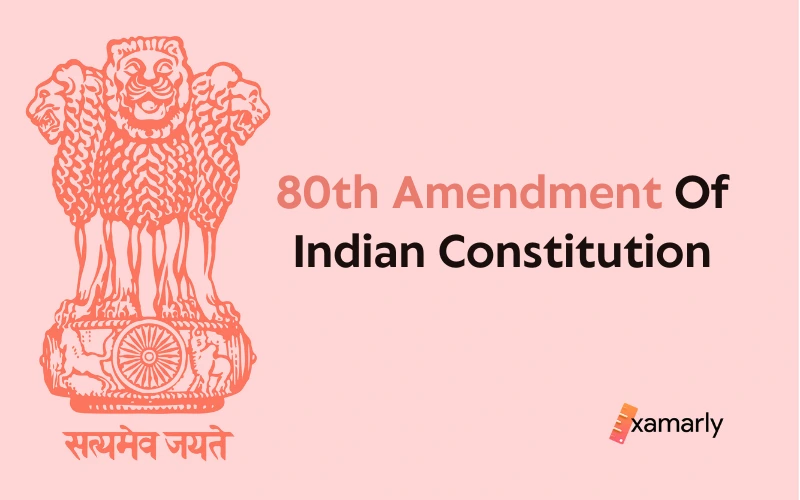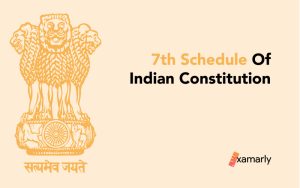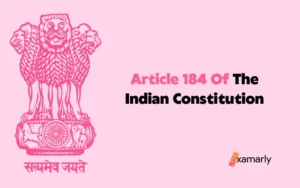The Constitution (Eightieth Amendment) Act, 1999 is the formal name of India’s 80th Amendment to the Constitution. The amendment’s goal is to implement the Tenth Finance Commission’s recommendation to streamline the tax systems by collecting and distributing all taxes between the states and the federal government.
Read this article further to learn more about the 80th amendment of the Indian Constitution. Also, you will understand the reason behind the need for such an amendment and much more information.
What is the 80th Amendment of the Indian Constitution?
On 9 June 2000, the Eightieth amendment came into effect. When this amendment was passed, Atal Bihari Vajpayee was the prime minister. In the Republic of India’s fifty-first year, this amendment was approved.
This constitutional amendment modifies articles 269 and 270. It also removes article 272 from the Indian constitution.
- The Constitution (Eighth Amendment) Act of 2000 established an alternative scheme for allocating taxes between the State and the Union. This was done in accordance with the Tenth Finance Commission’s suggestions.
- In accordance with the new scheme for devolution of revenue between the States and the Union, the States will receive grants in place of income taxes on railway passenger fares and twenty-six percent of the gross proceeds of Union taxes and duties in place of their current share of income tax, excise duties, and special excise duties.
Objects And Reasons
The Constitution (Eighty-Ninth Amendment) Bill, 2000, which became the Constitution (Eightieth Amendment) Act, 2000, had a statement of purposes and justifications attached to it.
- The Tenth Finance Commission presented its report on the 26th of November,1994. The report covered the five-year period beginning in 1995–1996 and ending in 1999–2000. The aforementioned report was placed before both Houses of Parliament on March 14, 1995. Among the proposals made by the Commission that has been taken under reference by the Government is a different system for splitting the proceeds of various union taxes and charges between the union and the states.
- The alternative scheme calls for the States to receive grants in place of income tax, basic excise duties, special excise duties, and excise taxes on railway passenger fares in exchange for twenty-six percent of the gross proceeds of Union taxes and duties, which would replace their current share of these taxes. Stamp duty, excise duty on medical toilet preparations, Central Sales Tax, Consignment tax, and cesses imposed for certain reasons under any law passed by Parliament and Surcharge are not included in this.
- Additionally, the States will get a 3% share of the gross proceeds from all Central taxes and duties in place of their current Additional Excise Duties in place of Sales Tax on tobacco, cotton, and sugar. Stamp duty, excise duty on pharmaceutical and toiletry products, Central Sales Tax, Consignment Tax, cesses imposed for certain purposes under any law passed by Parliament, and Surcharges are not included in this. Tobacco, cotton, and sugar may continue to be excluded from sales tax, according to the commission’s proposal. Additionally, the Basic Excise Duties on these commodities may be combined with the Additional Excise Duties in place of Sales Tax.
- Whether the alternative strategy would be more beneficial for the Center or the States compared to current arrangements would depend on the proportionate rise in the Collection of various Central duties and taxes to be grouped.
- The Commission has outlined the advantages of the plan in para 13.2, 13.3, and 13.18, their reports 13.3 and 13.18, respectively. Following are these areas:-
- (i) The States will be able to share the aggregate buoyancy of Central taxes with a specific portion of the aggregate revenues from Central taxes allocated to them;
- (ii) Without having to take into account whether a tax is shareable with the states or not, the Central Government can undertake tax reform;
- (iii) both the Central and State Governments would be affected by changes in Central tax income;
- (iv) There is a higher chance that the taxes specified in paragraphs 268 and/or 269 will become a part of this agreement; and
- (v) If the tax sharing arrangement scope is expanded to provide more confidence about the certainty of resource flows and more flexibility in tax reform, the progress of reforms will be significantly accelerated.
- The Commission’s suggested plan is in the best interest of the country. The justification for this is that keeping Cesses and Surcharges outside the pooling arrangement helps to eliminate a perceived inter-tax in the Government of India’s tax mobilization effort while maintaining enough flexibility to fulfill the Centers’ unique demands.
- On December 20, 1996, a Discussion Paper outlining various components of the plan was placed on the tables of both Houses of Parliament. It was done in an effort to cause an informed debate.
- The then-Government had agreed in general to accept the plan suggested by the Tenth Finance Commission subject to a few revisions based on a consensus achieved at the Third Meeting of the Inter-State Council held on July 17, 1997.
- The Government had made the decision to uphold, subject to a few revisions, the decision made by the previous Administration regarding the adoption of the plan proposed by the Tenth Finance Commission.
- First, the Tenth Finance Commission did not recommend freezing the percentage share of the State for fifteen years, but rather subjecting it to periodic review by succeeding Finance Commissions.
- Second, instead of following the Tenth Finance Commission’s suggestion for the distribution of gross proceeds, the government decided to distribute net proceeds. This is done to keep the consistency between articles 270, 279, and 280 of the Indian Constitution. However, the United States will not suffer any loss as a result. Due to the fact that the government also opted to make up for it by appropriately increasing the percentage share above 29%.
- Thirdly, no changes are being sought to Article 271 of the Indian Constitution, which allows the Central Government to collect surcharges on Central taxes and customs for Union-related purposes, as the Commission had planned.
- From April 1st, 1996, the scheme will be in effect. From 1996–1997 through 1999–2000, the States will get 29% of the net proceeds, as determined by the net proceeds’ percentage share. The 11th Finance Commission’s recommendations, which have a deadline of 30 June 2000 for its final report, will apply to the five years starting on 1 April 2000.
- This Bill aims to change articles 269, 270, and 272 of the Constitution in order to carry out this judgment. This is done in order to make many central taxes and levies, such as corporation tax and customs duties, comparable to personal income tax in terms of their legally required share with the States.
Related Articles:
| Article 279 Of The Indian Constitution | Article 280 Of The Indian Constitution |
| Article 81 Of The Indian Constitution | Article 281 Of The Indian Constitution |
Important Provisions in the 80th Amendment Of the Indian Constitution
Amendment of article 269 – Clauses (1) and (2) of Article 269 of the Indian Constitution shall be replaced by the following clauses:
“(1) The Government of India will levy and collect taxes on the sale, purchase, and consignment of commodities, but on or after the first day of April 1996, those taxes will be allocated to the States. In addition, will be regarded to have been done so in accordance with clause (2)”
Explanation – In accordance with this provision,
(a) Whenever expression taxes on the purchase of products or sale is used, it refers to taxes imposed on purchases of goods other than newspapers made through interstate trade or commerce;
(b) No matter whether the consignment is made to the maker or to a third party, the expression taxes on the delivery of commodities must entail taxes on the consignment of goods if such consignment happens within the course of interstate trade or commerce;
(2) The net proceeds from any such tax in any fiscal year, with the exception of those that are attributable to Union territories, are to be allotted to the State where the tax is leviable during that fiscal year and not to the Consolidated Fund of India. Additionally, shall be allocated to those States in accordance with such principles of distribution that Parliament may establish through legislation.
3. Substitution of new article for article 270 – Article 270 of the Indian Constitution shall be replaced by the following article. Further, shall be deemed to have been substituted with effect as of the first day of April 1996, namely:-
Distribution of taxes between the States and the Union:
‘270. (1) Except for the taxes and duties referred to in articles 268 and 269, respectively, the surcharge on taxes and duties referred to in article 271, and any cess levied for specific purposes under any law made by Parliament, all taxes and duties referred to in the Union List must be imposed and collected by the Government of India. Further, distributed between the States and the Union in accordance with clause (2).
Check out the linked Article 268 of the Indian Constitution to learn about it.
(2) The Consolidated Fund of India will not receive the prescribed percentage of the net proceeds of any such tax or duty in any given financial year; instead, it will be distributed to the States where the tax or duty is imposed in that year. Additionally, shall be allocated among those States in accordance with the clause, starting at the period that may be determined in clause(3).
(3) “Prescribed” in this article denotes:
(i) until a Finance Commission has been established as per the President’s decree,
(ii) following the formation of a Finance Commission and after the President has taken into account the Finance Commission’s recommendations.
4. (1) Removal of Article 272 – Article 272 of the Indian Constitution shall be removed.
(2) Regardless of what is stated in sub-section (1), any amount distributed to the States as grants-in-aid after April 1, 1996, but prior to the effective date of this Act, that is equal to all or a portion of the net proceeds of the Union duties of excise including additional duties of excise levied and collected by the Government of India, shall be deemed to have been distributed in accordance with the provisions of article 270.
(3) Any amount delivered as grants-in-aid to the States after April 1, 1996, but prior to the effective date of this Act, that is equal to all or a portion of the net proceeds of any other duty or tax, must be regarded to have been distributed in accordance with the guidelines in article 270.
Conclusion
The 80th amendment of the Indian Constitution came into effect on 9 June 2000. This constitutional amendment modifies articles 269 and 270. It also removes article 272 from the Indian constitution.
An “alternative scheme of devolution” of funds between the Center and states was contemplated under the Constitution (80th) Amendment Act of 2000. The Tenth Finance Commission’s recommendations were followed in implementing this. According to this, the states should receive a share of 29% of all central taxes and charges collected.
FAQs
What is the 80th amendment of the Indian Constitution?
The alternate tax-sharing plan between the Union and the States is covered by the 80th amendment to the Indian Constitution.






